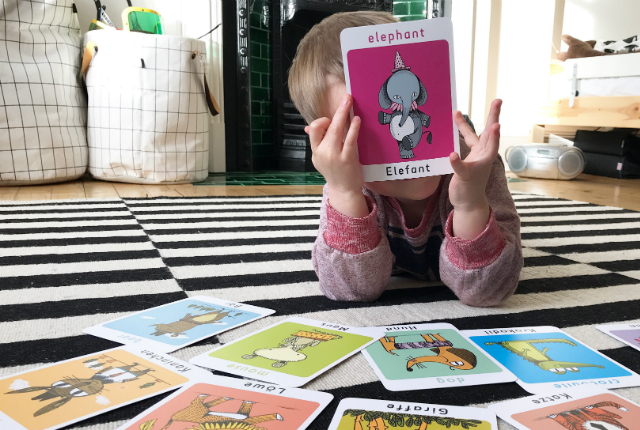
Review: Lil’ollo Bilingual Flashcards [AD]
A little while ago, I introduced you to Lil’ollo and their beautiful world maps. Today, I wanted to tell you a little more about this small independent business, which also produces beautiful bilingual flash cards and games. Lil’ollo was founded by Alex, who lives in the UK with her Italian husband and two children, so is herself raising a bi-cultural and bilingual family. I joined the Lil’ollo champion’s network last year, and besides reviewing their map, was delighted to also be sent a free complete set of their flash cards, including the animals, colours, numbers and shapes packs. So today, I’d like to show you a bit more about these flash cards and how you can use them. If you read all the way to the end of the post, you can also pick up an exclusive discount code to use if you decide to order any cards yourself.
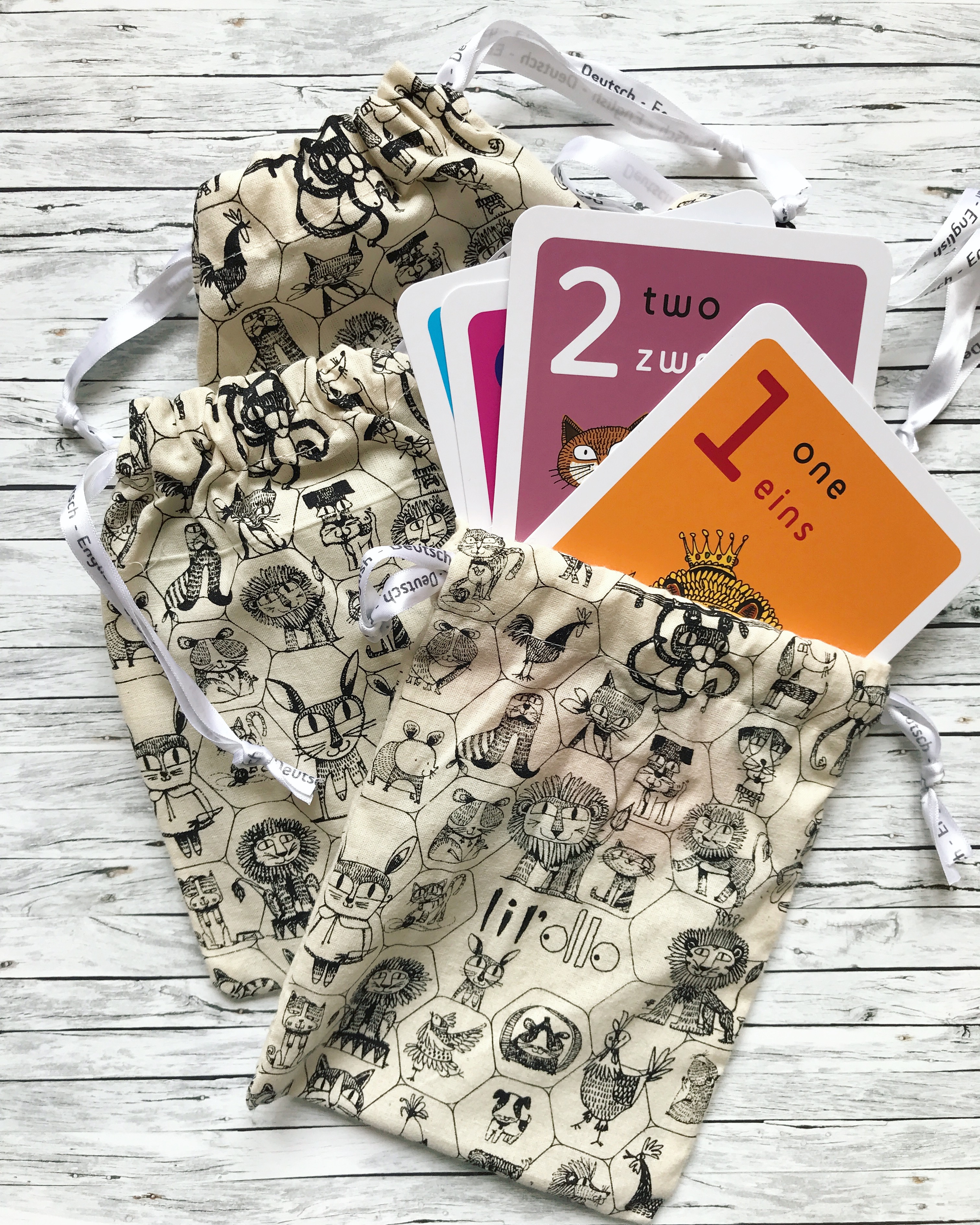
First of all, the technical aspects. Each pack includes ten flash cards, which come packaged in a cotton drawstring bag. Just like the maps, the flashcards – and the bags – feature the cute animal illustrations that all of the Lil’ollo products have in common. The cards are nice and chunky, ca. 10.5cm x 15cm, perfect for small hands. Whilst it is advised to keep the cards away from water, they do have a special coating and can survive a few splashes and spills. Washable children’s pens apparently also wipe off them, which we haven’t tried ourselves, but I picked up this tip from the Lil’ollo Instagram feed. All of the flash cards are bilingual, and include English + one other language, including Dutch, French, German, Italian, Polish, Spanish and Welsh. As well as ordering the physical cards from their online shop, there is also the option to download a ‘print at home’ version at a reduced price, which additionally includes traditional and simplified Chinese as another language option. There are also plans to introduce more languages in the future. We were sent a set of English + German flash cards to review, perfect for our little family.
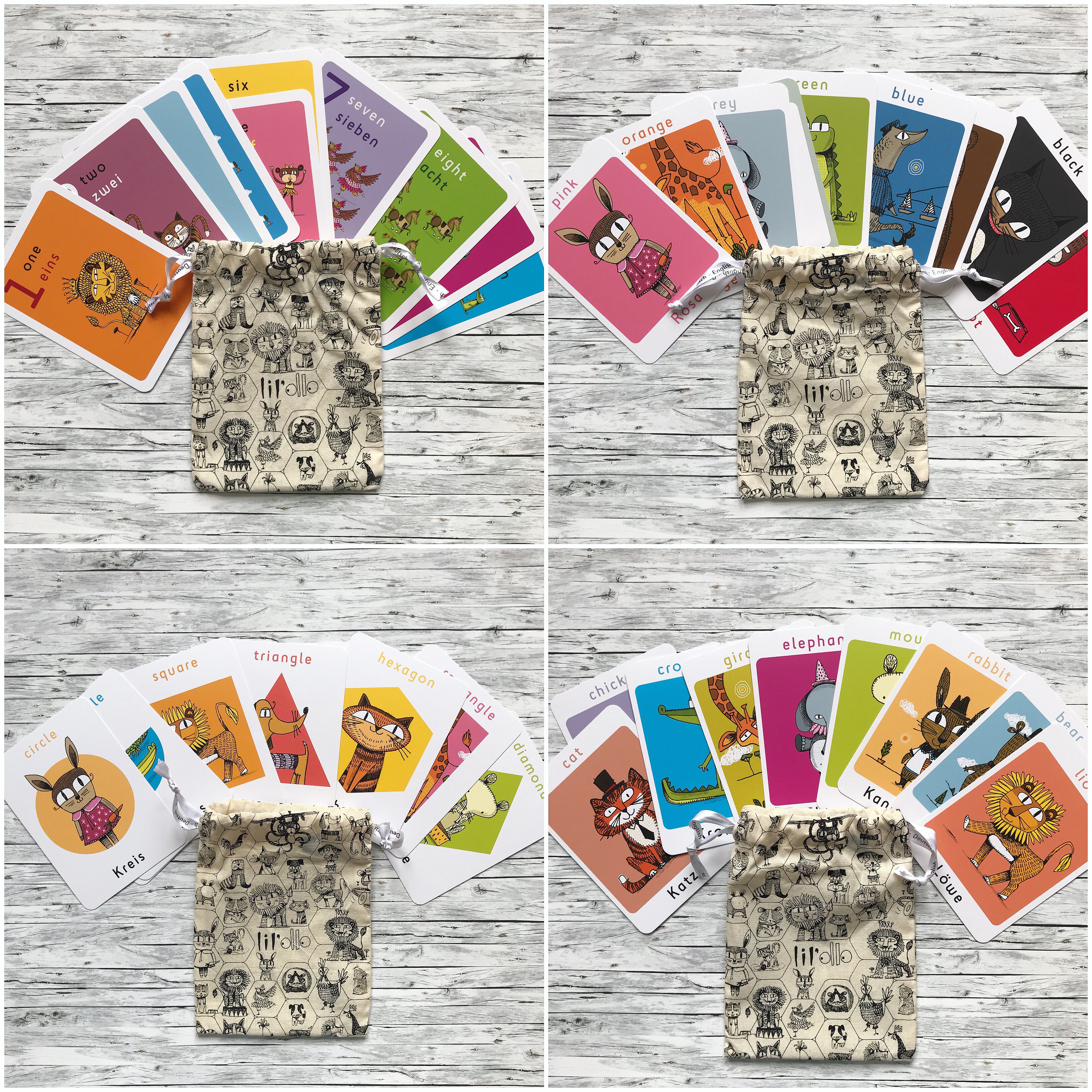
So, how can you use these cards with your kids? The possibilities are endless, if you let your imagination run free, and you can pick up lots of great ideas from the Lil’ollo Instagram feed. But today, I am going to share with you two ideas for each of the packs. So that’s eight ideas in total, to get you started! Are you ready?
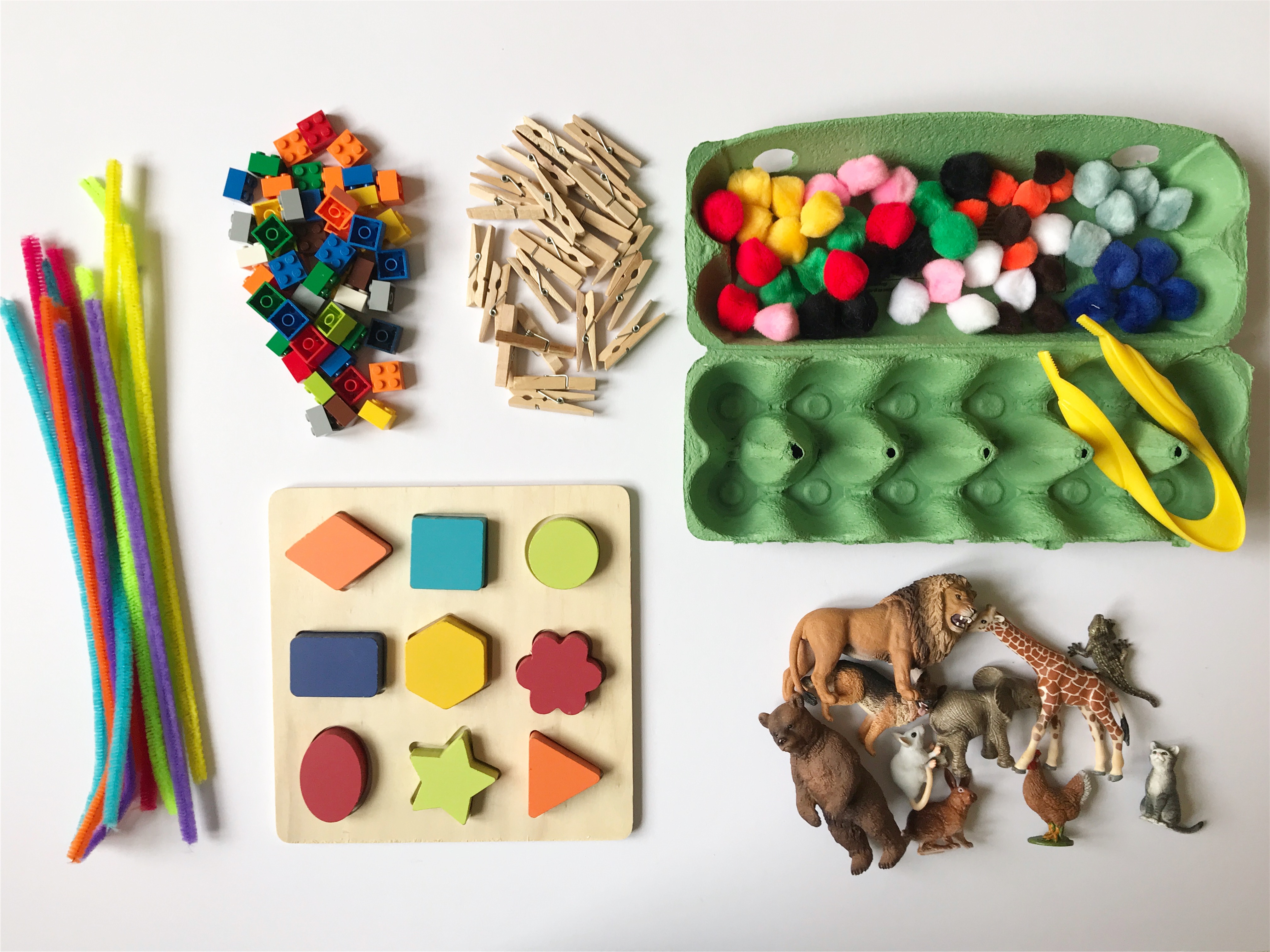
Here is an overview of the props I gathered:
- pipe cleaners
- an assortment of Lego bricks
- mini clothes pegs
- multi coloured pom poms + kids tweezers (optional)
- a shape puzzle
- an assortment of animals from our Schleich collection
Assisting me with the review, was my 3 year old (a.k.a. Mr Fox). Just as a side note, we’ve been using these cards for a couple of months now, and testing out different ideas. I hadn’t taken any photos before, because I just wanted to let him explore the cards without feeling like he was being put on show, and for me to just concentrate on him without faffing around with my camera all the time. But yesterday after nursery we did one big photoshoot, to capture all our favourite ideas so far, and it seems like Mr Fox enjoyed the opportunity to “help mummy with her work”.
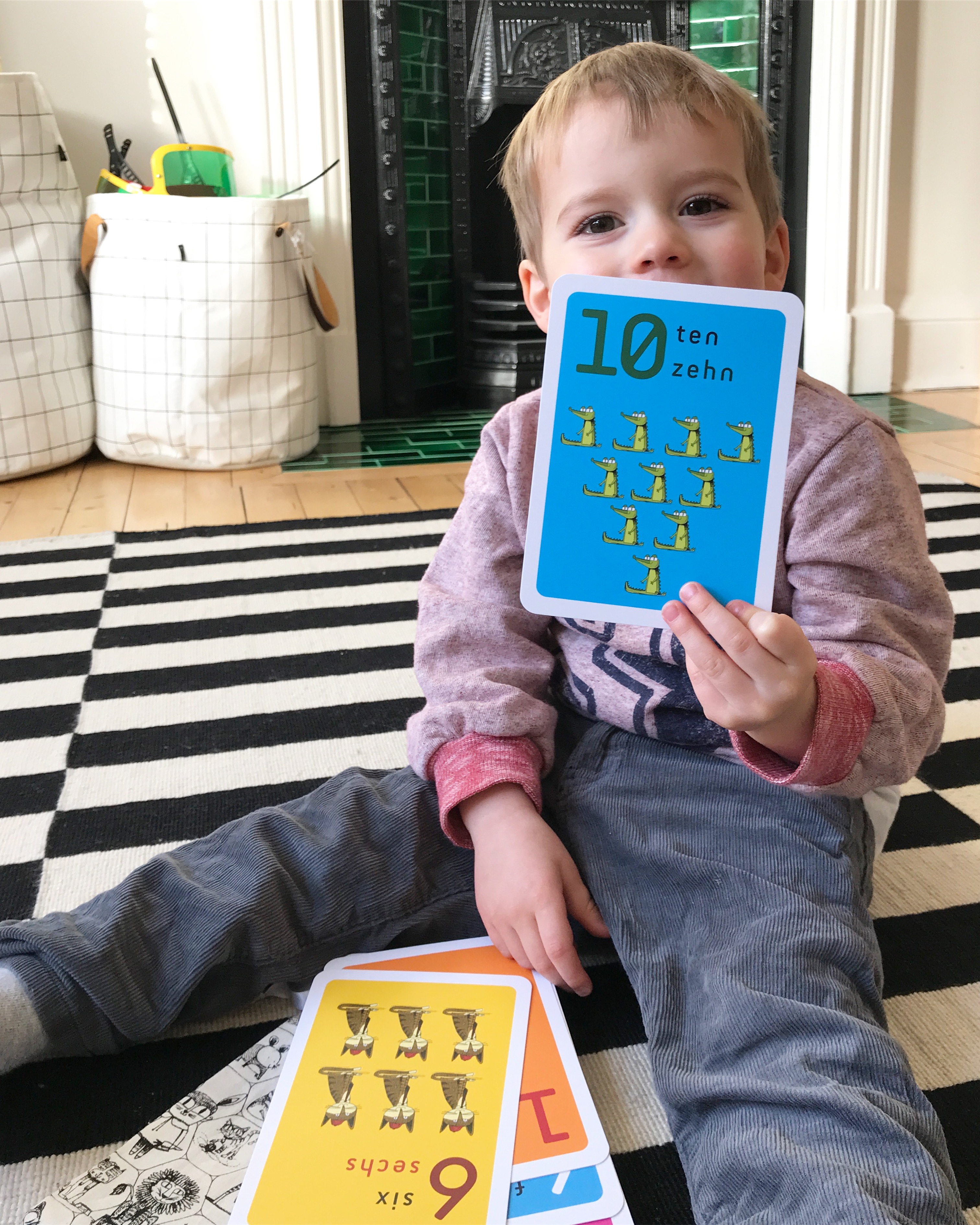
Numbers
For the number flash card activity, we used the Lego bricks and the clothes pegs.
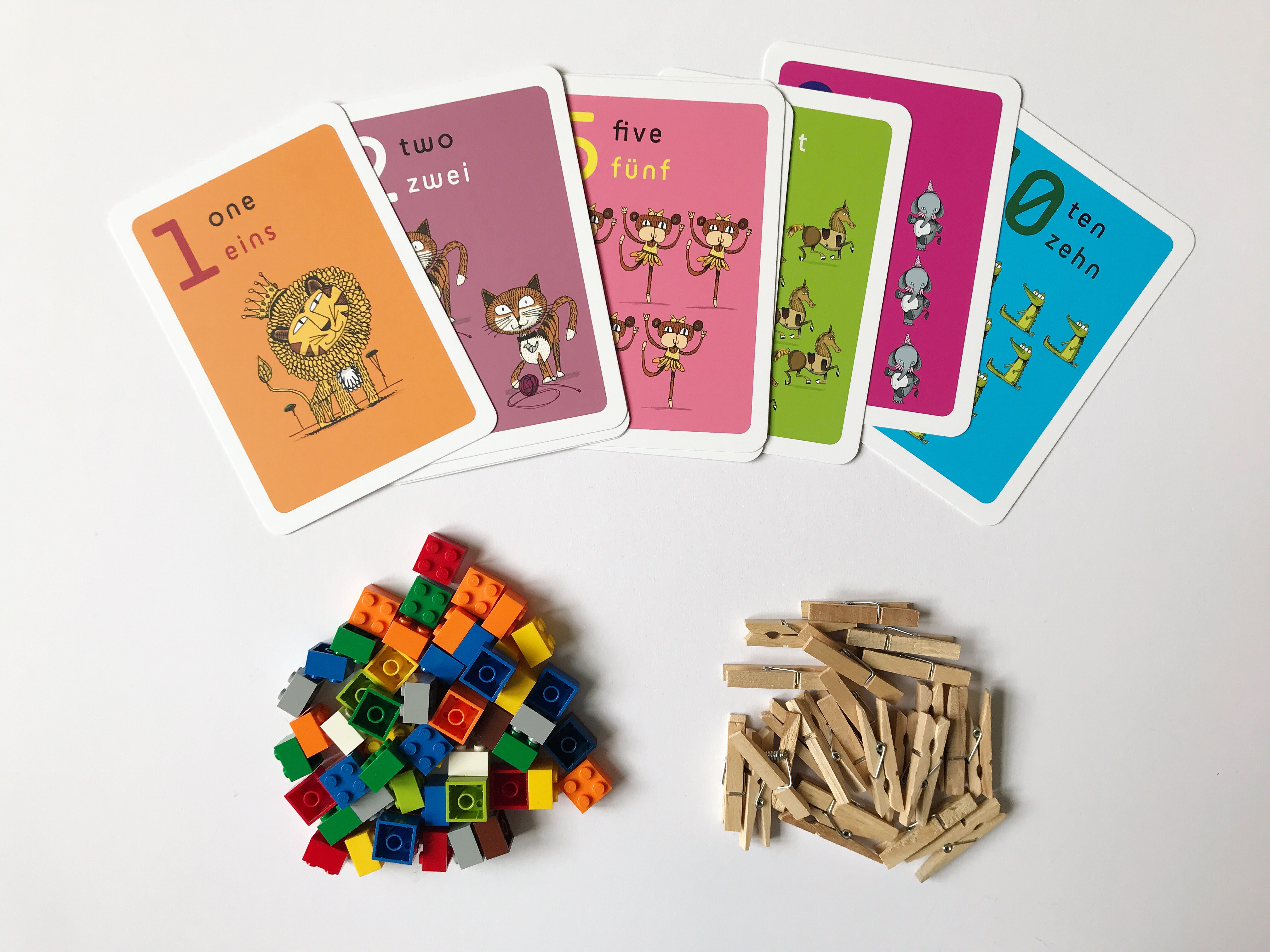
We actually had a third activity for this, because we started out by arranging the numbers in the right order from 1 to 10.
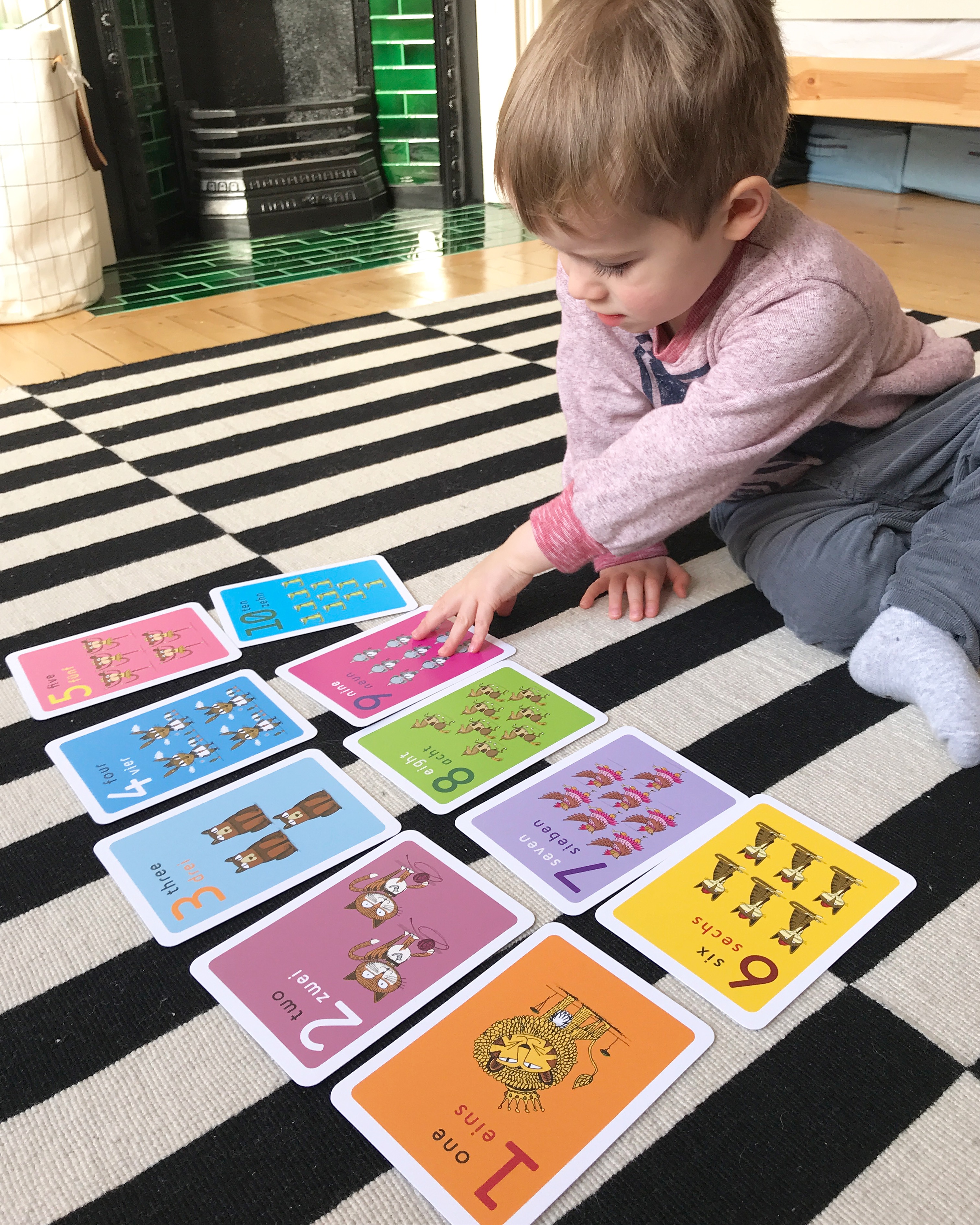
Then we got out the Lego bricks. To make it a little bit more fun, we loaded them in to a toy truck, which then ‘delivered’ the bricks to the cards. I had pre-sorted a different colour of brick for each number, e.g. one dark blue one, two white ones, three light green ones etc. all the way to ten. The task was to find all the bricks from one colour, count how many there were, then match them to the corresponding flash card. A slightly simpler version of this activity, would be to simply have a mixed assortment of bricks and count out the corresponding number for each card, regardless of the bricks’ colours.
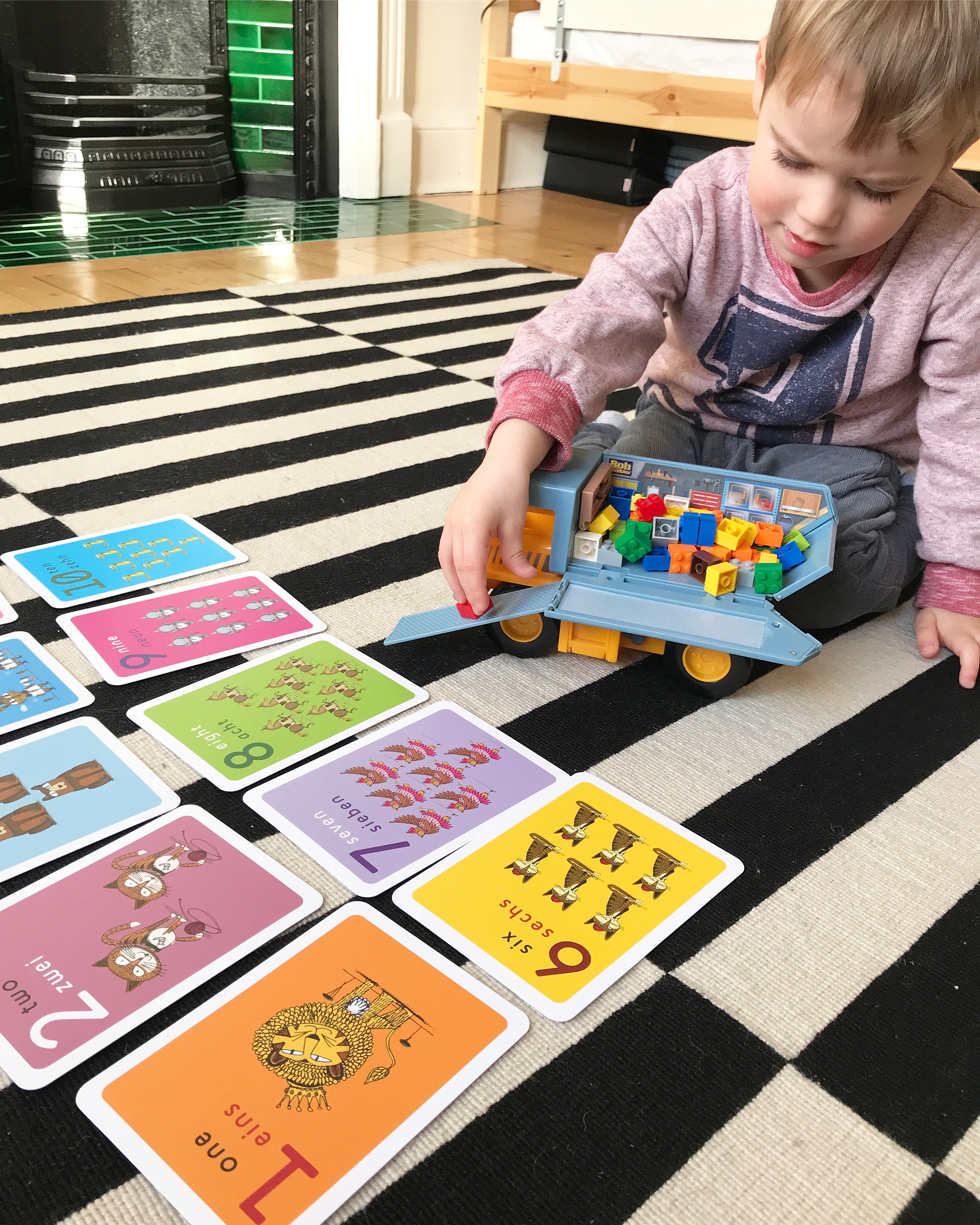
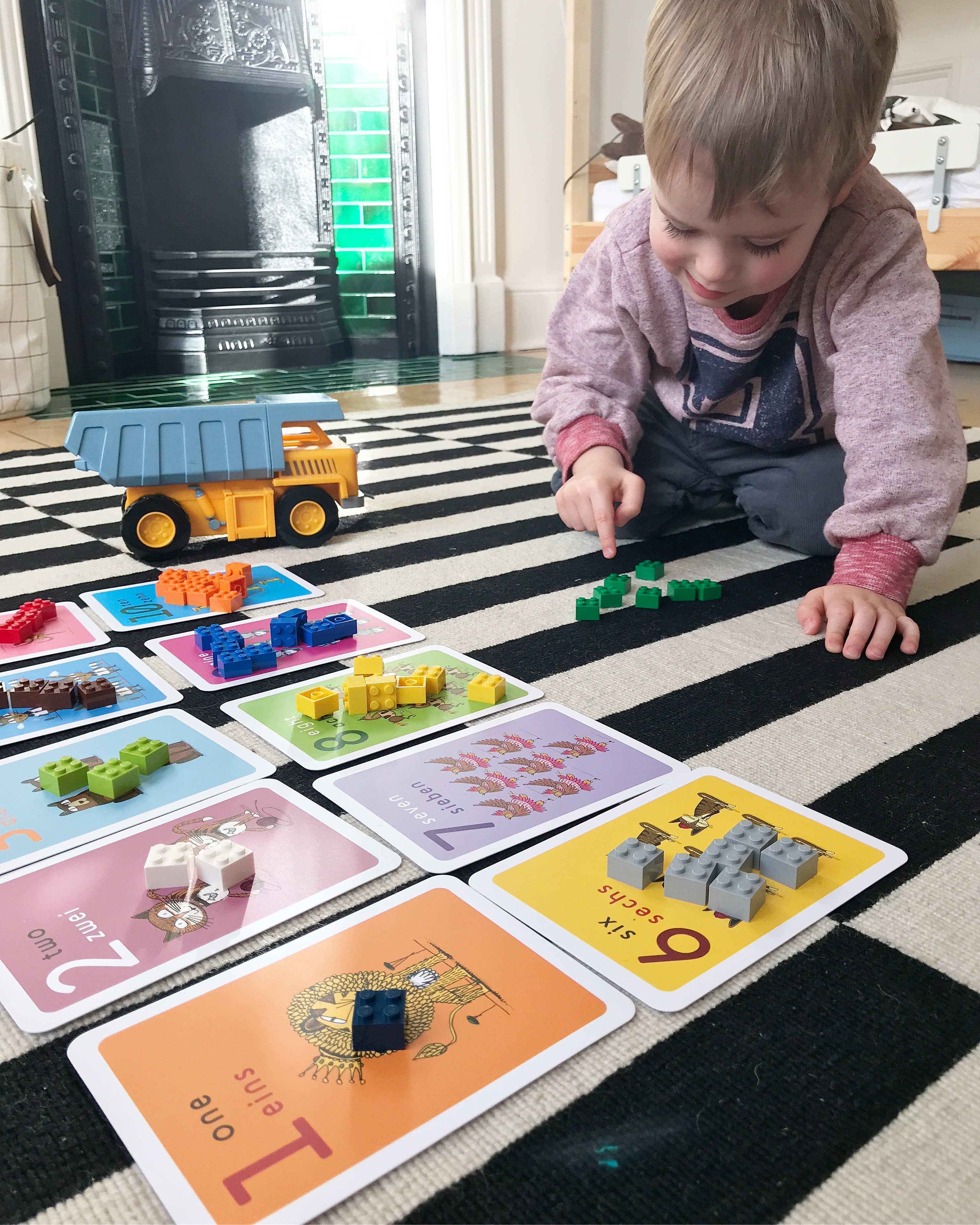
The final activity for the number cards, was to use the clothes pegs and clip the corresponding number of pegs on to each card. As well as numbers and language, this is also a great exercise for fine motor skills.
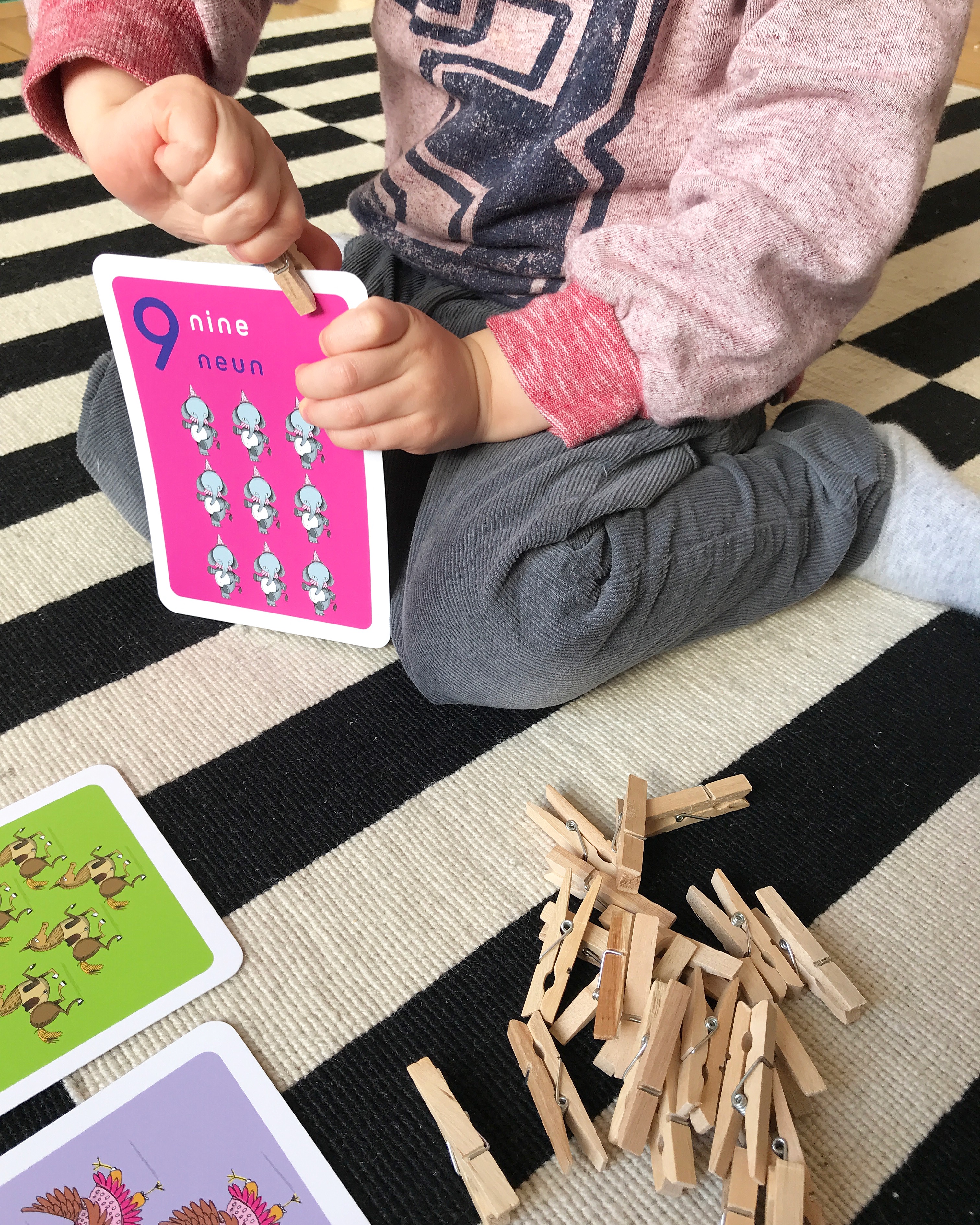
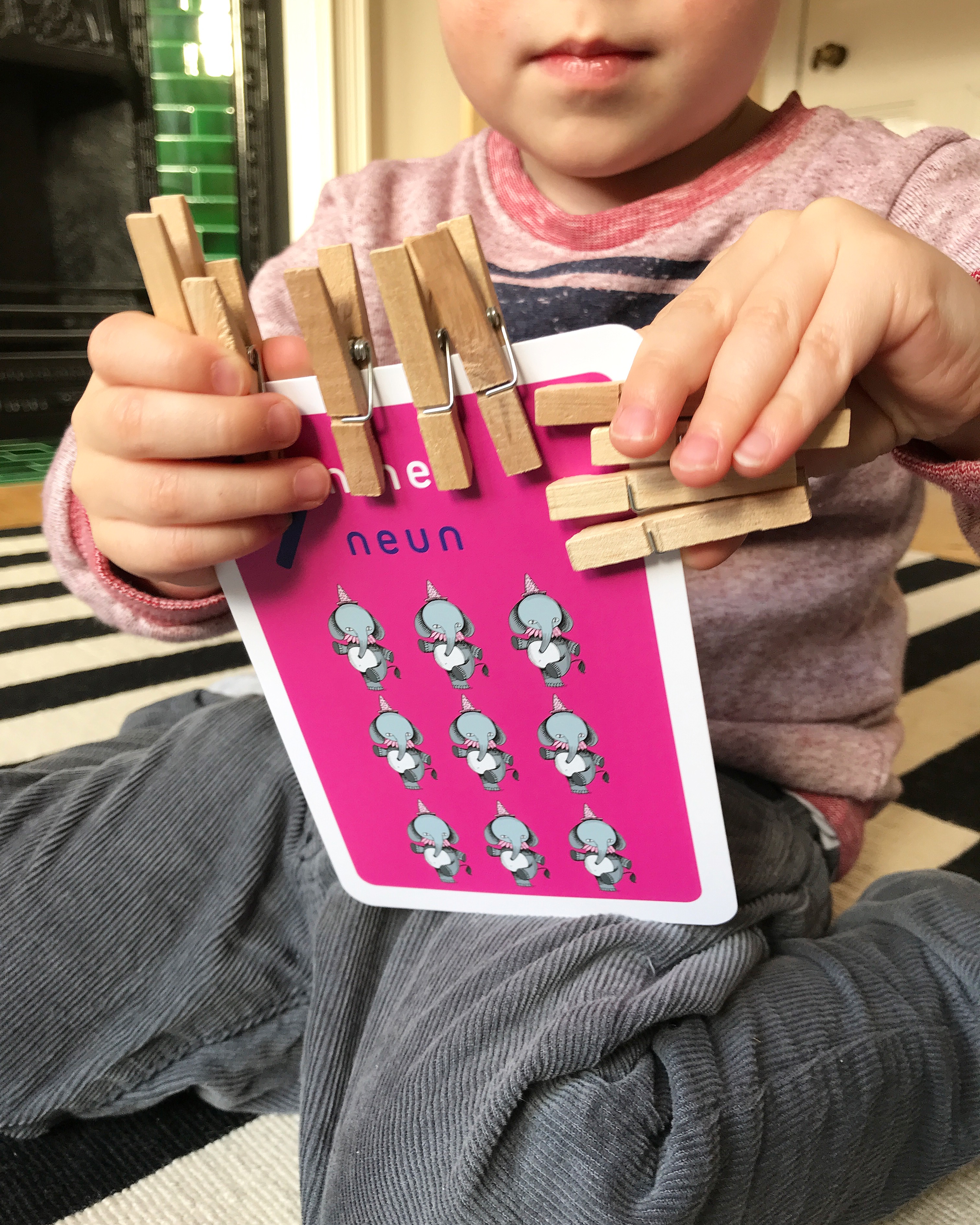
Colours
For the colour flash card activities, we used an assortment of multi coloured pompoms (there were five of each colour) and a pair of kids tweezers. The latter is optional, you could also just use your hands, but it adds an extra level of fine motor skills practice to the activity. I used an empty egg carton as a tray for the pom poms, but you could use anything.

The idea was to pick up all the pom poms with the tweezers, and put them on the cards with the corresponding colours. You can vary the number of pom poms according to your kids’ attention span.
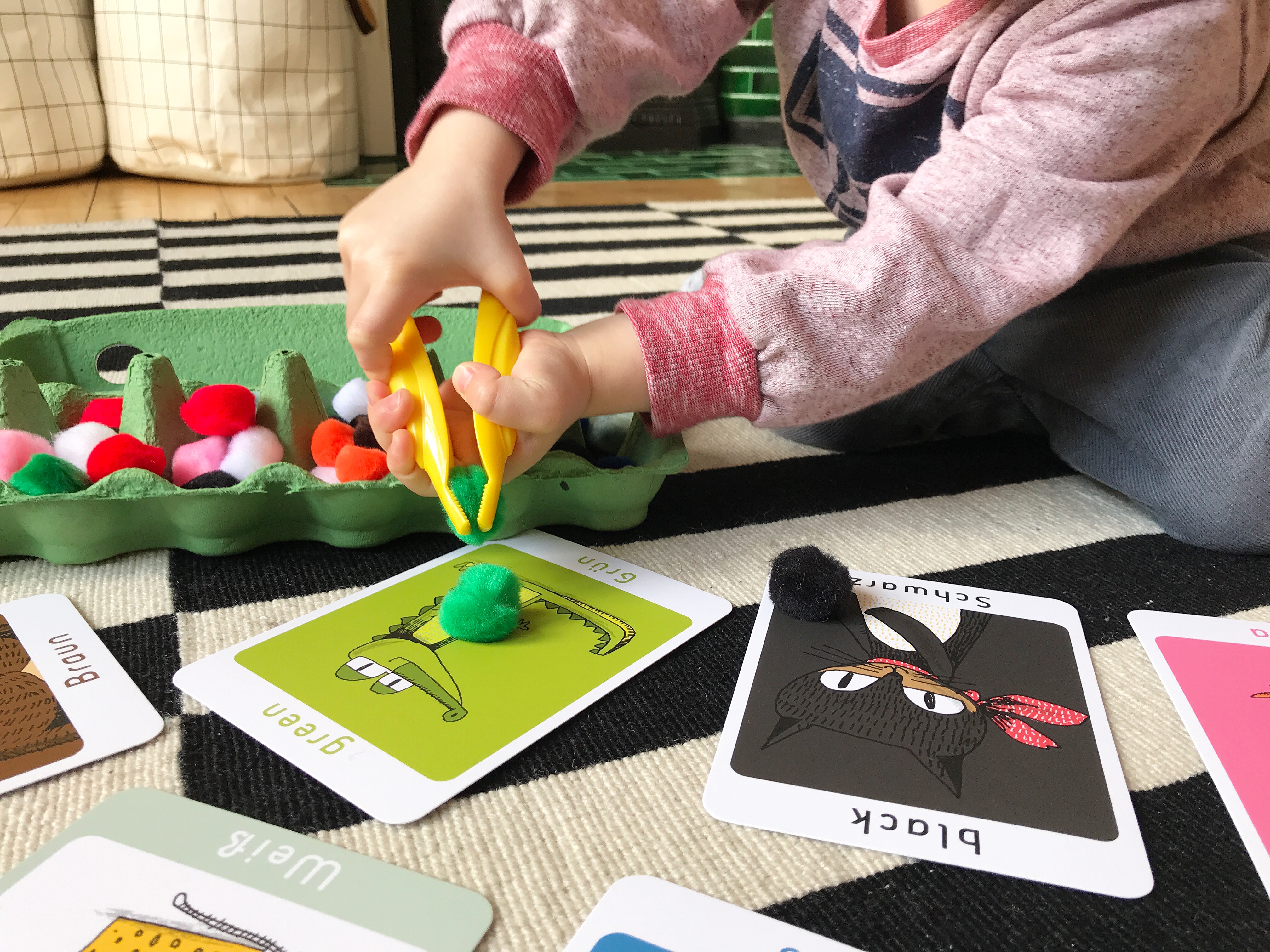
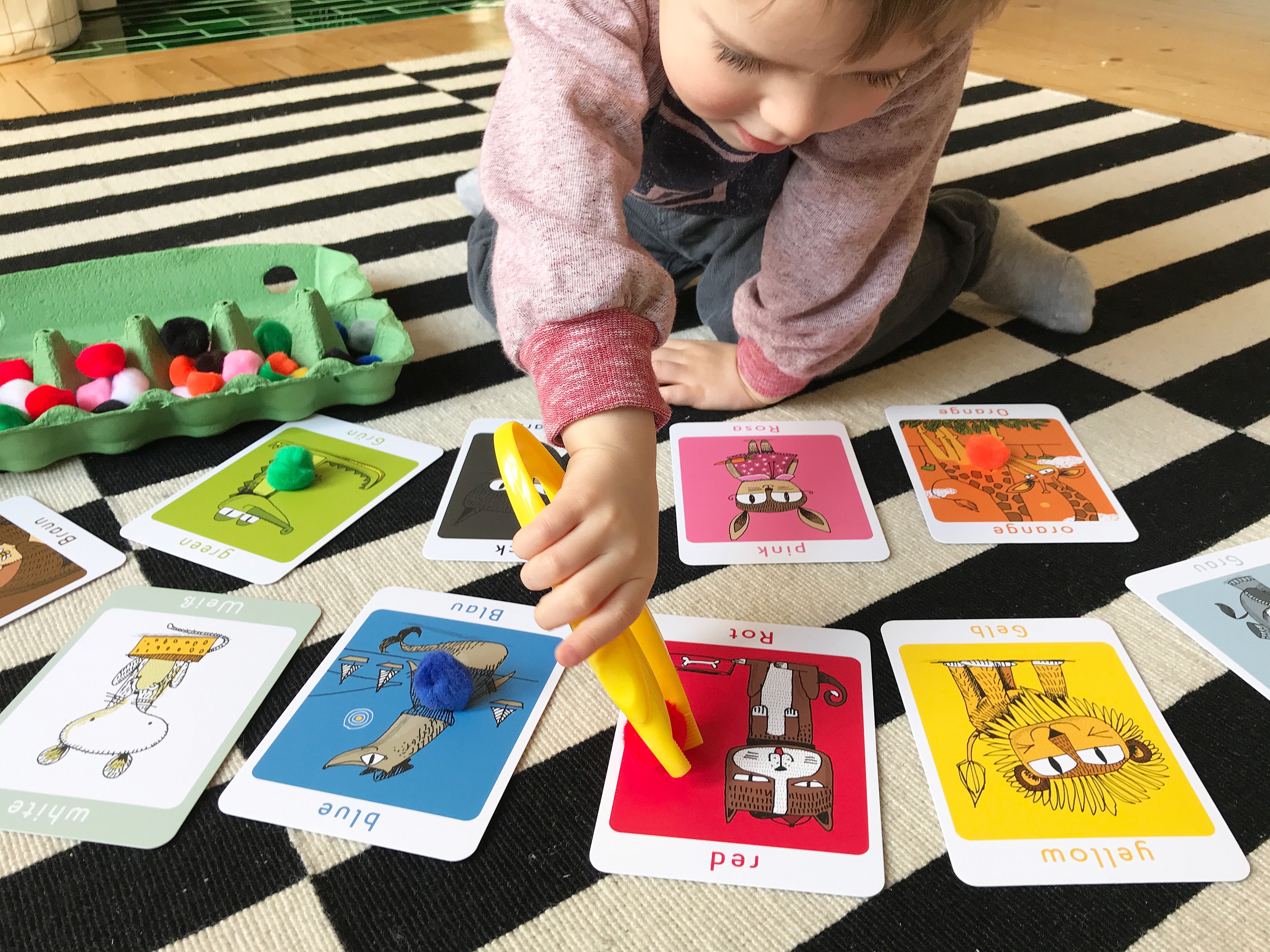
The second colour activity didn’t include any pre-prepared props. Instead, we went on a colour ‘treasure hunt’ around the boys’ room. This was Mr Fox’s favourite activity out of all the activities we did! In one of the photos, he is laughing his head of because he just put a donut on the rabbit’s face. Haha!

He was so excited about it, he couldn’t wait to tell his dad and big brother all about it at dinner time. Bless. You could also extend this activity to include the rest of the house. And if you were doing it with more than one kid, you could have them find one thing each per colour.

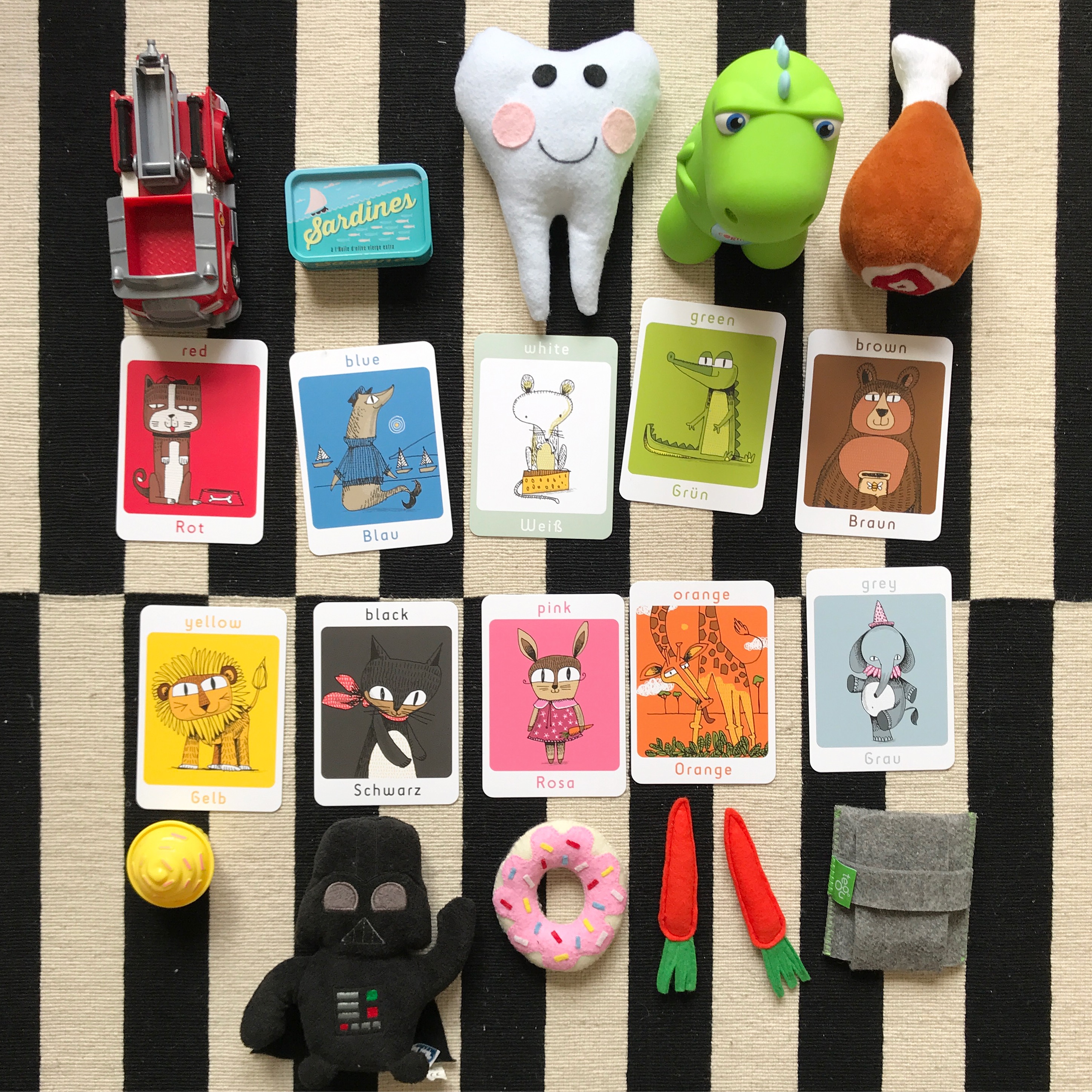
Animals
For the animal flash card activities, we used an assortment of plastic animals from our Schleich collection, and our voices! By the way, Mr Fox would like to have you know that his favourite animal card is the elephant.
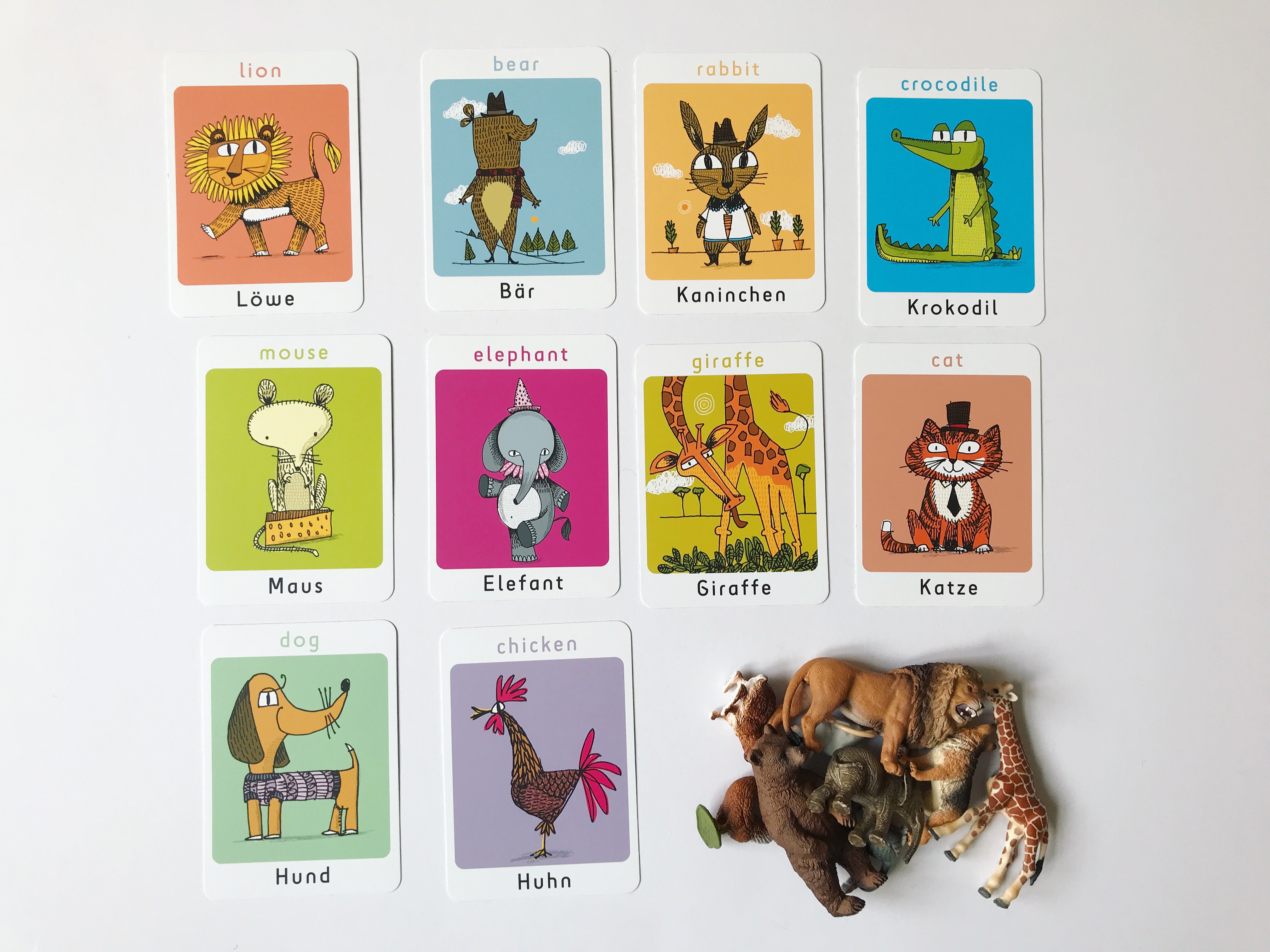
For the first activity, we simply matched the animals to the cards. This was apparently also a great opportunity to practice our animals noises! Did you know that some animals make different noises in different languages? For example, a dog goes ‘woof woof’ in English but ‘wau wau’ in German. And an English cockerel goes ‘cock-a-doodle-doo’ whilst a German one goes ‘kickerikie’. So we were making bilingual animal noises as well as bilingual animal names.

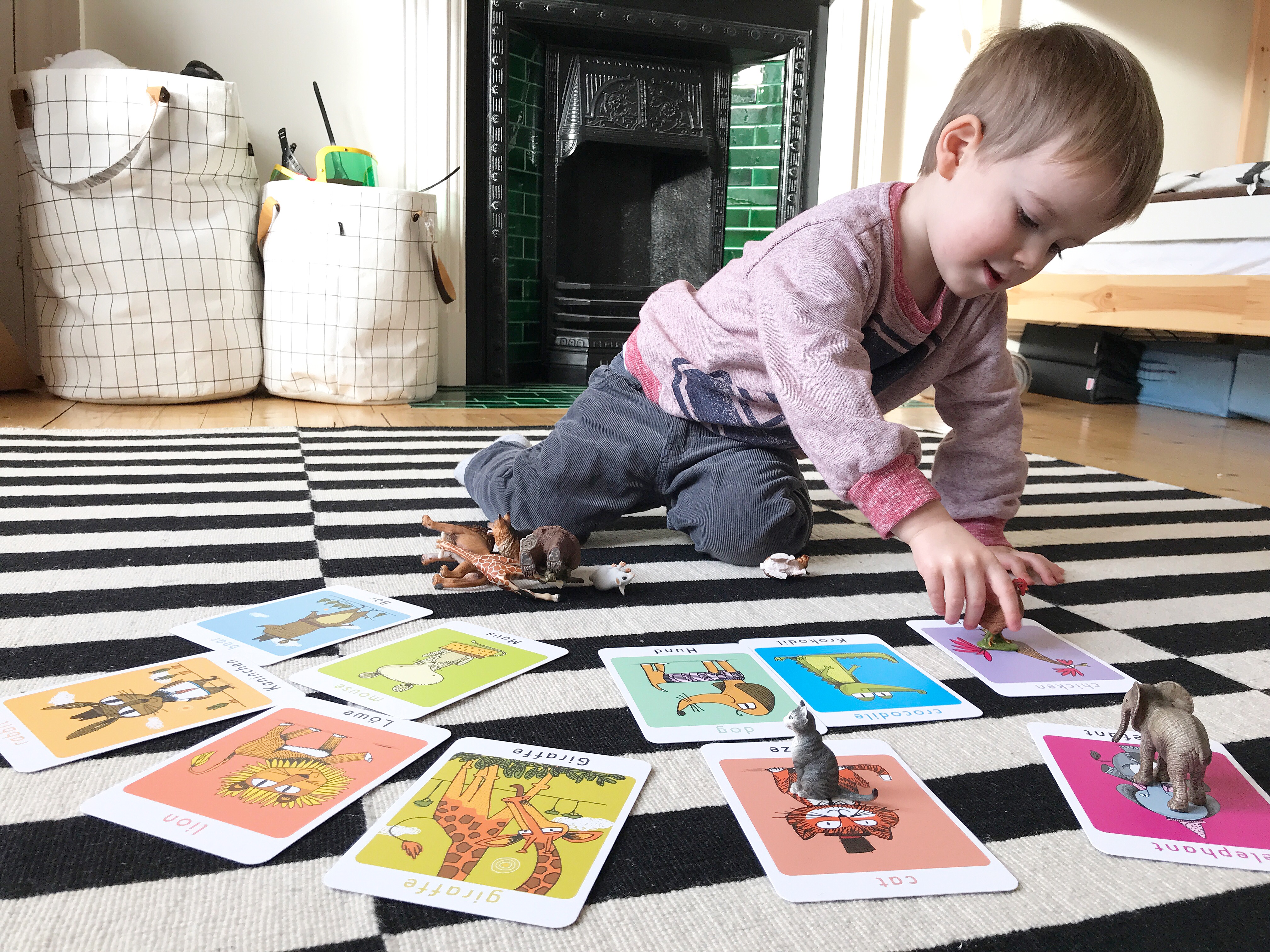
For the second activity, we sang ‘Old Macdonald had a farm’ (Or ‘Old Macdonald hat ne Farm’ in German). We shuffled the cards, turned them face down, and then at the appropriate point in the song – “and on that farm her had a…” – turned over the top card to see what animal to sing about next. Some of them, like the giraffe and the rabbit, were a bit of a challenge. Since it looks like the giraffe is eating grass in the picture, we decided on “munch munch”, and for the rabbit we had “hop hop”.
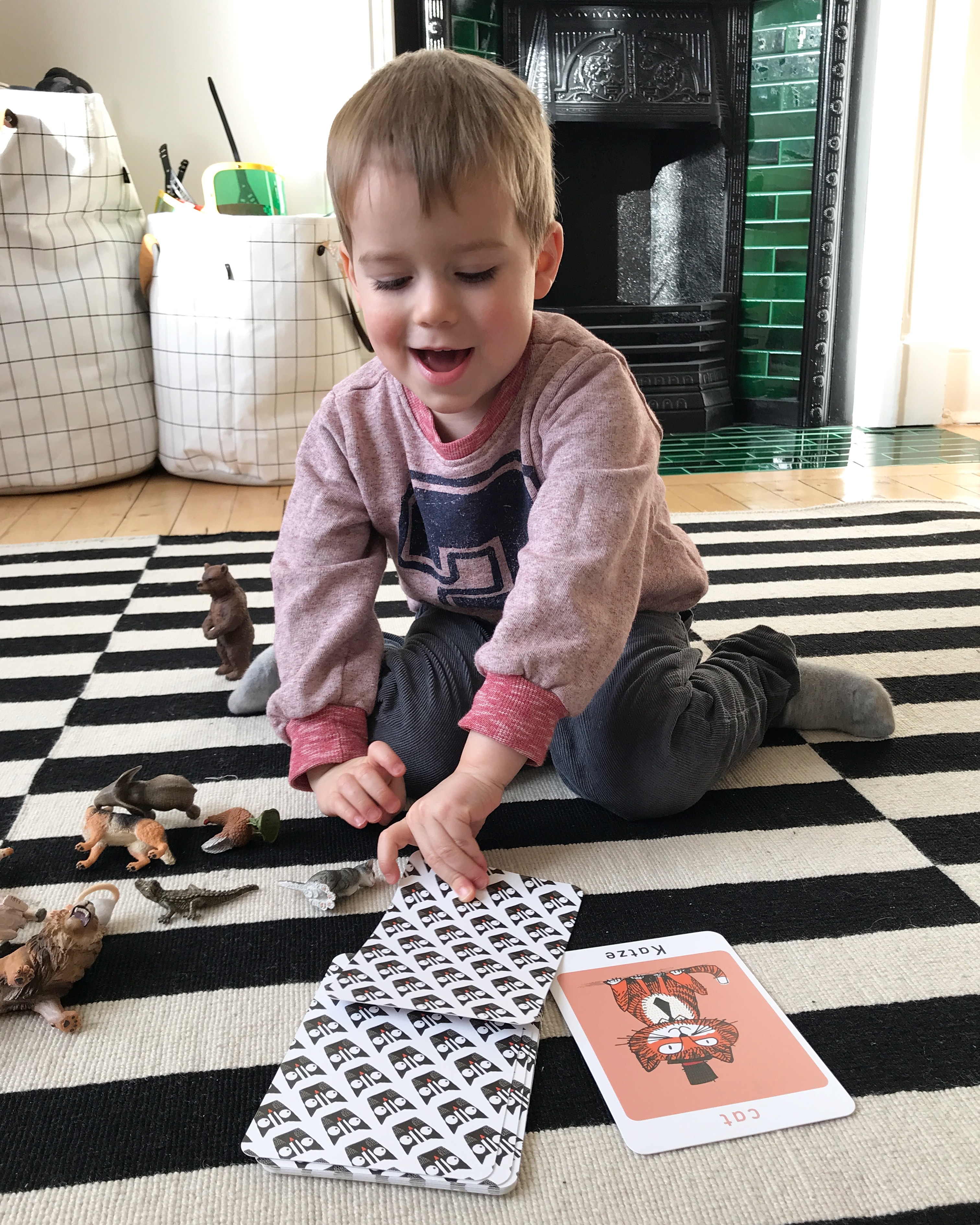
Shapes
Finally, shapes. For the shape flash card activities, we used a shape puzzle we already had, and some pipe cleaners.
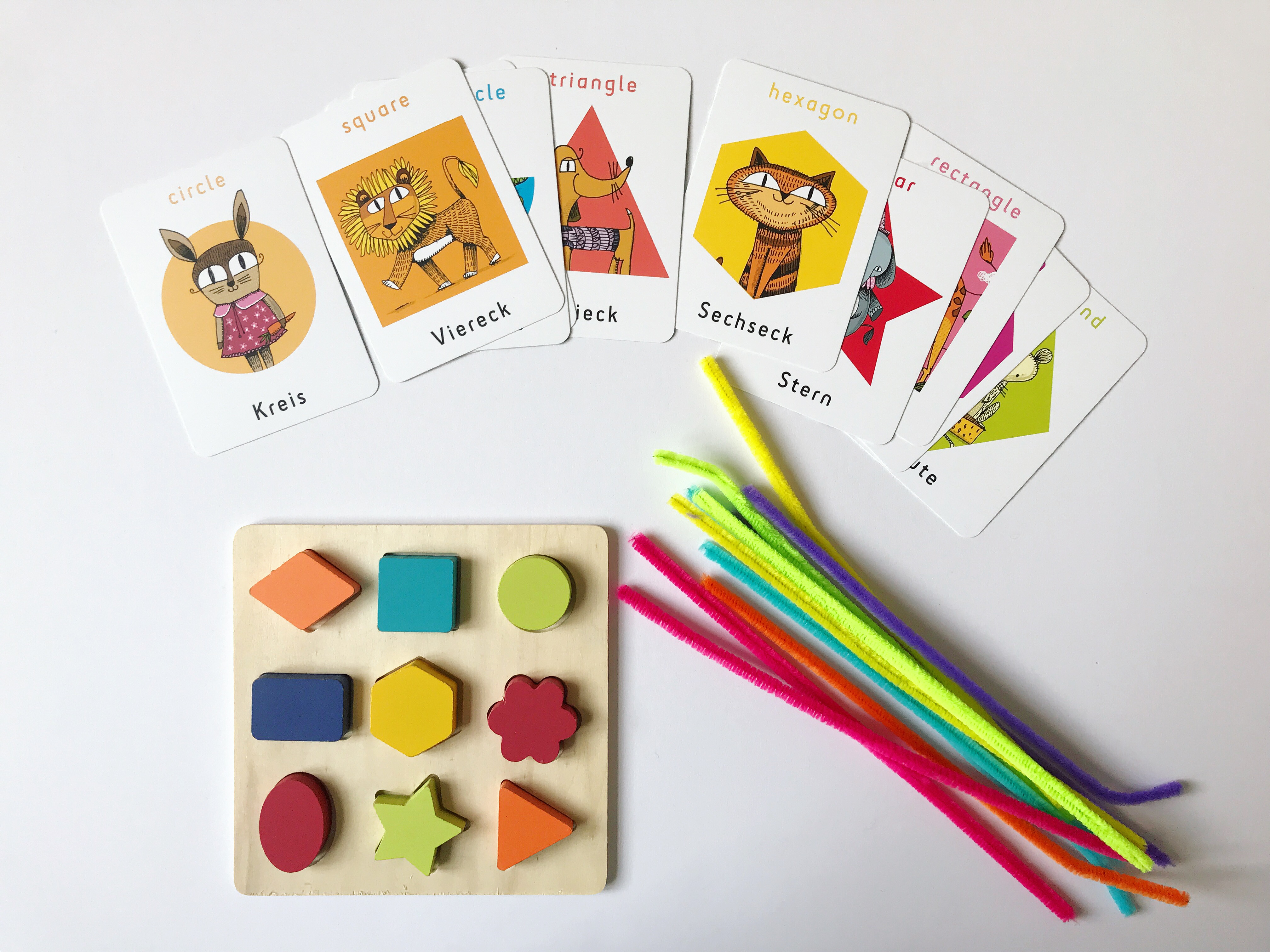
The first activity, was to match the shapes from the puzzle to the cards. There are ten cards but only eight matching shapes (the puzzle doesn’t have an octagon or semi-circle), but that didn’t really matter. The second activity was to use the pipe cleaners to make the shapes. Mr Fox needed a bit of help from mummy for this, especially for the more complicated shapes like the star and the multi-sided shapes, but he did quite well on his own for the circle, oval and triangle.
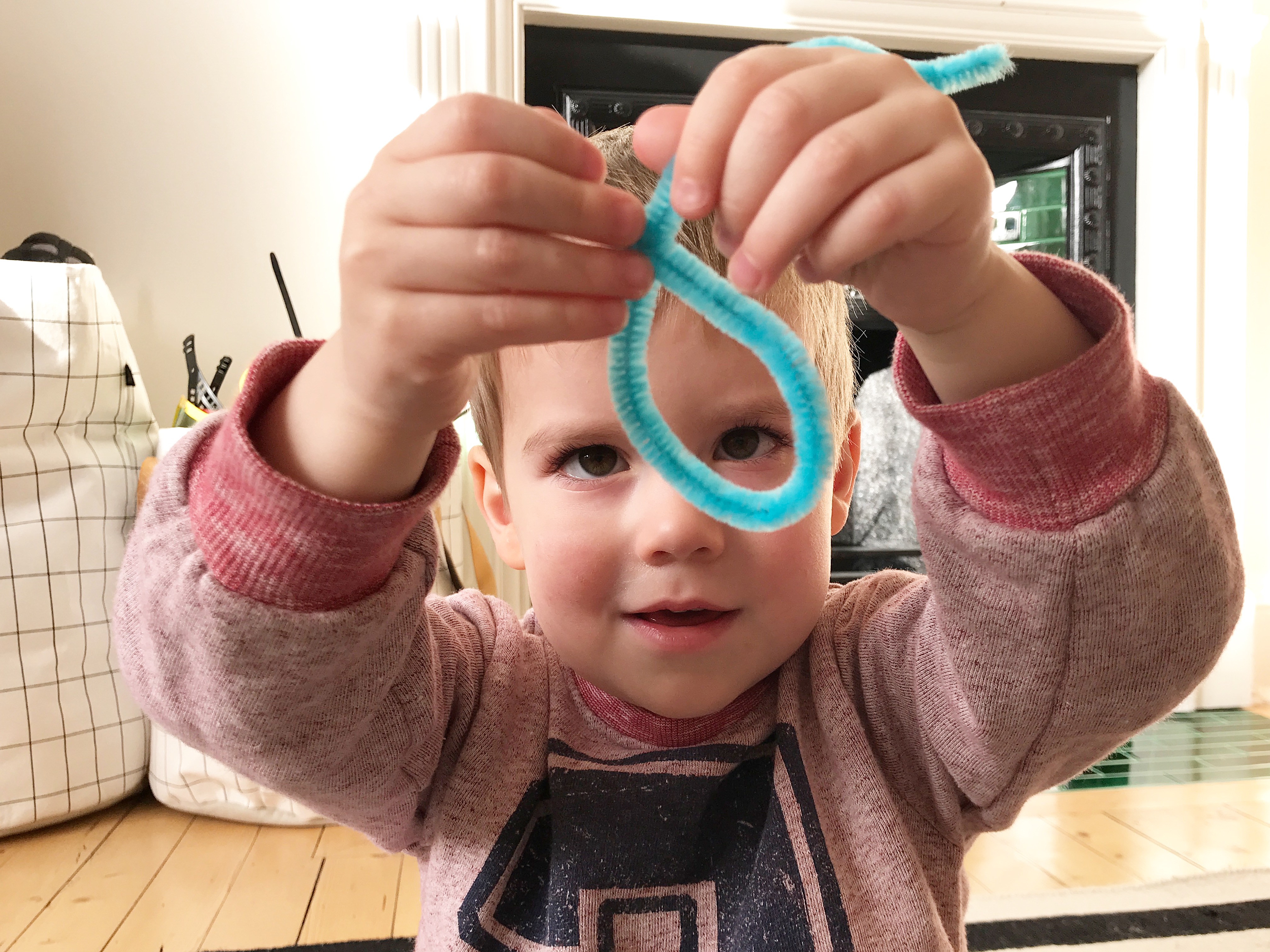
And although we’ve done these as separate activities in the past, his attention span was obviously running out at this point, so he decided we were combining the two activities and putting the puzzle shapes and pipe cleaner shapes down at the same time.
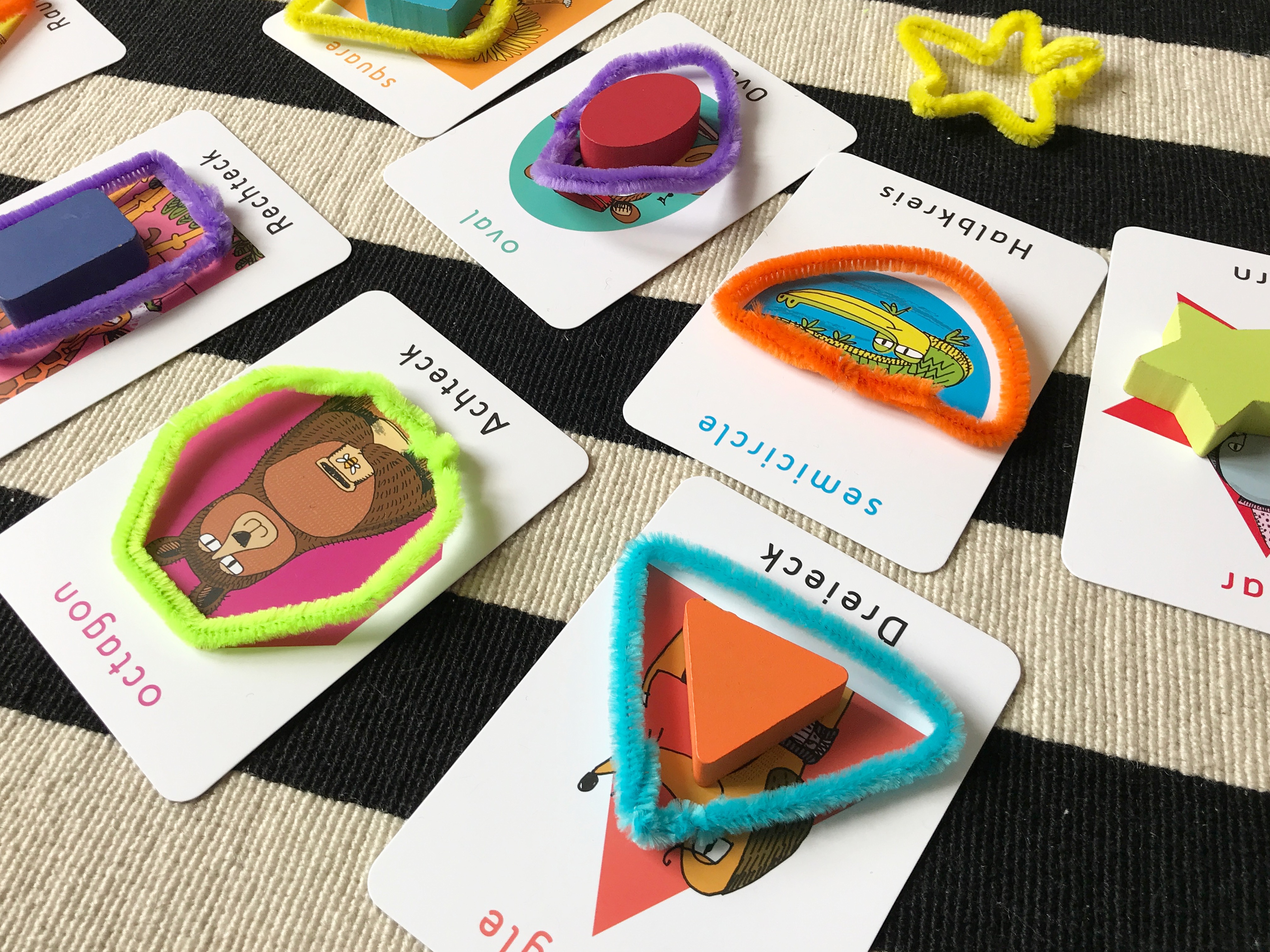
We finished off with Mr Fox singing ‘Twinkle Twinkle, Little Star’, which apparently is his favourite shape.
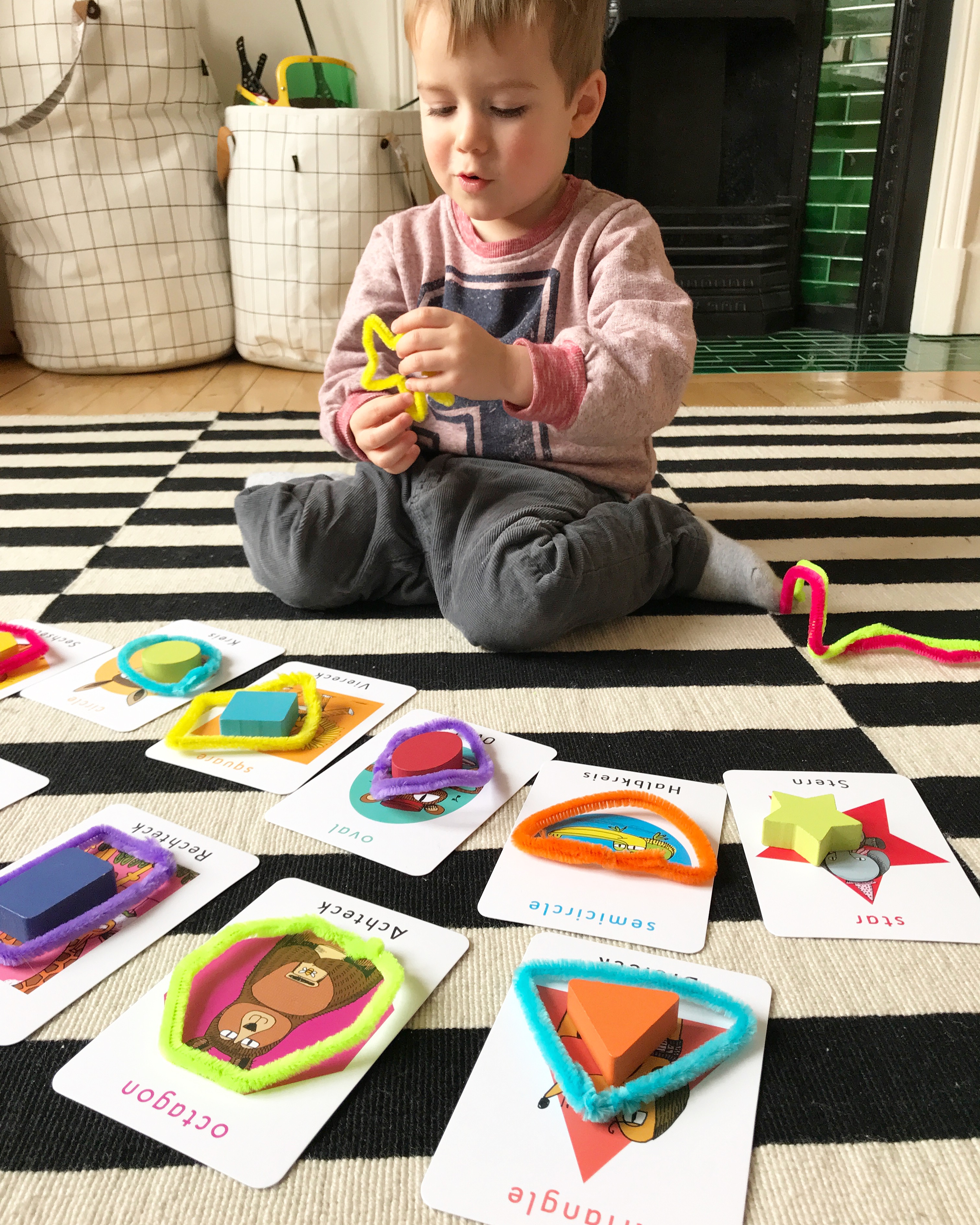
Just one final note on the bi-lingual side of things. Since Mr Fox can’t read yet, you may be wondering how the bi-lingual aspect is reinforced. German is his weaker language (which I will write a little more about in a separate post soon), so that is the main language I use with him when we play with these cards. But then I’ll also repeat the English words for each of the shapes, colours and animals, or rather I’ll ask him what it is. Or if he says an English word first, I’ll ask him what the German word is. So whenever we use the cards, he will hear (and say) both languages for each word. When we are counting, we count first in German and then again in English.
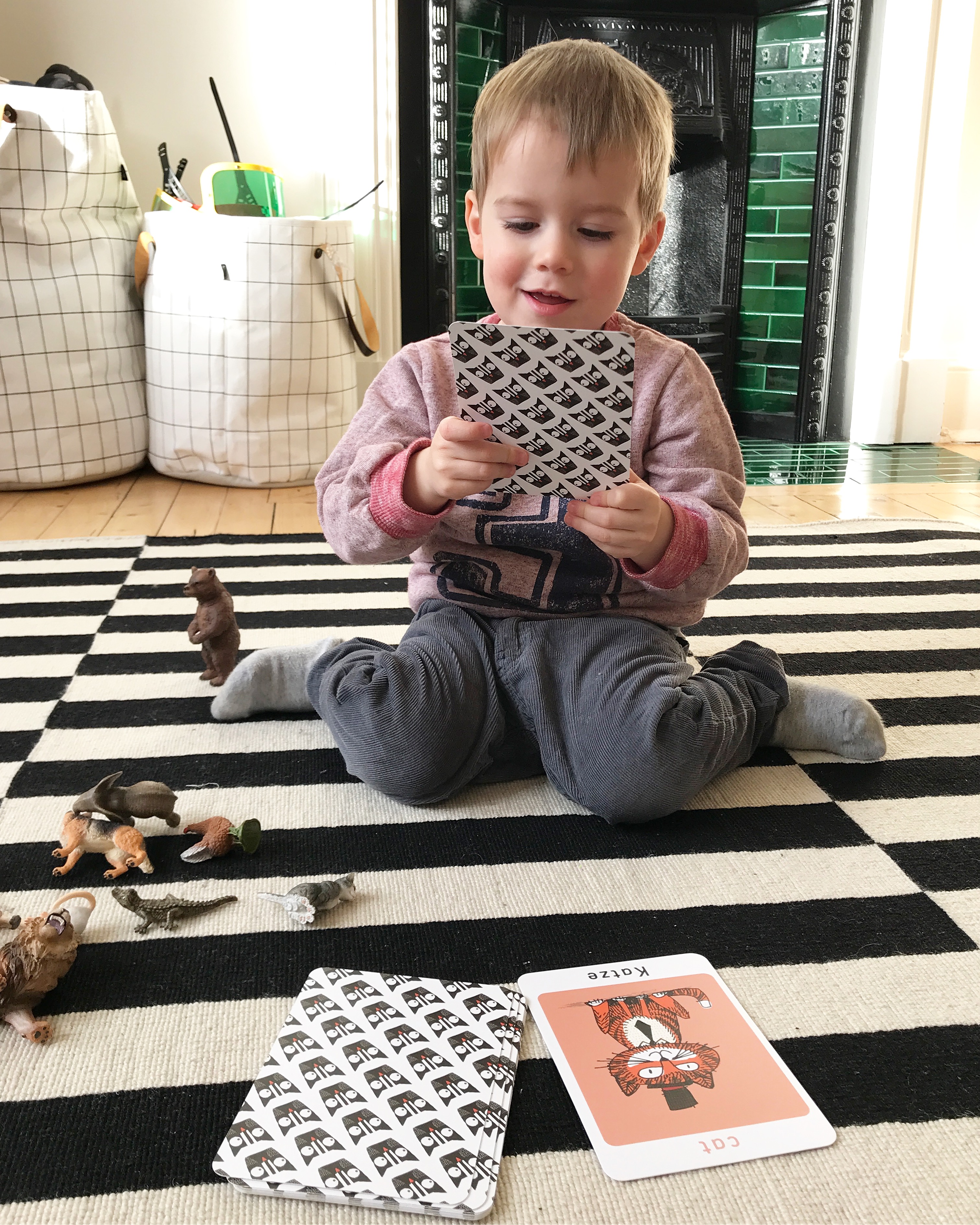
So, those are just some of our favourite ideas on how to use the cards. I hope it’s enough to get you started. I would love to hear any other ideas you have – please feel free to share them in the comments below. If you would like to order some flash cards from the Lil’ollo shop, you can enter the code BEARANDFOX at the checkout, to get 10% off your order!
Disclosure: We received four free packs of bi-lingual flash cards from Lil’ollo for review, but all images and views are our own. Also, if you use the discount code, not only will you get 10% off your order, but I will get a 15% commission, at no extra cost to you.
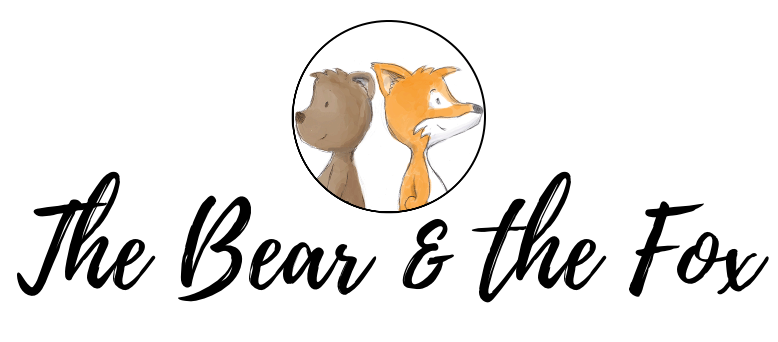



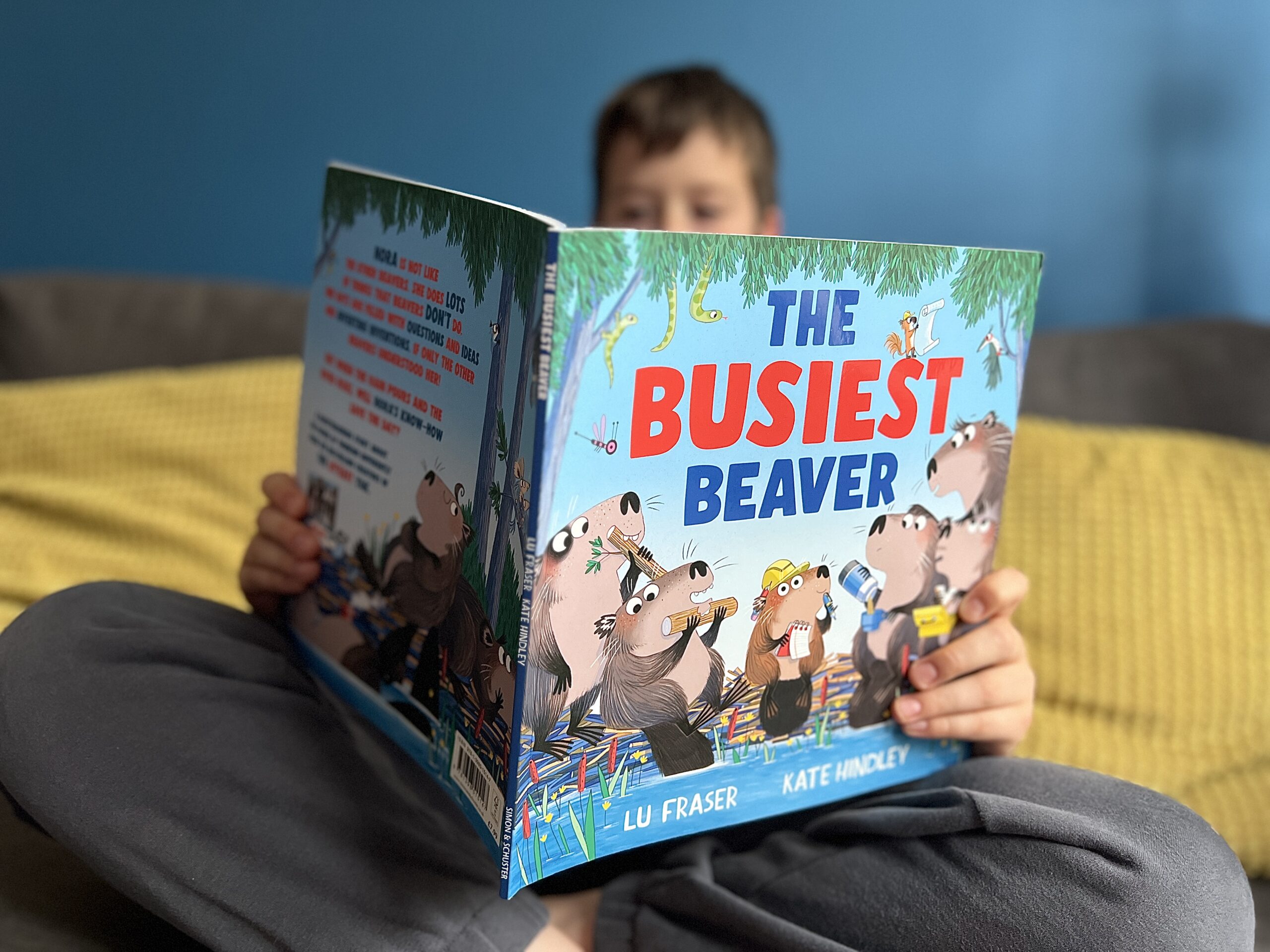
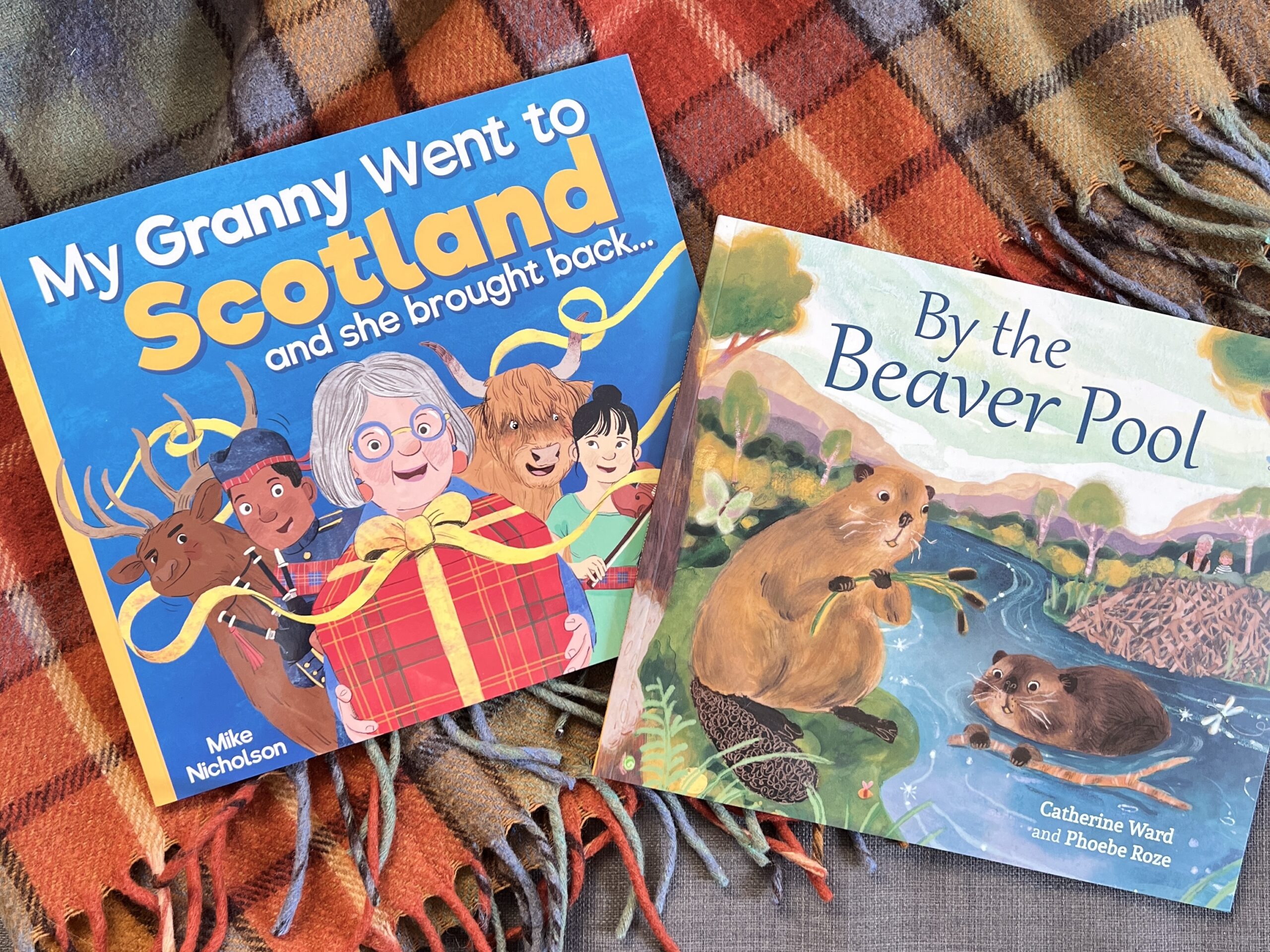
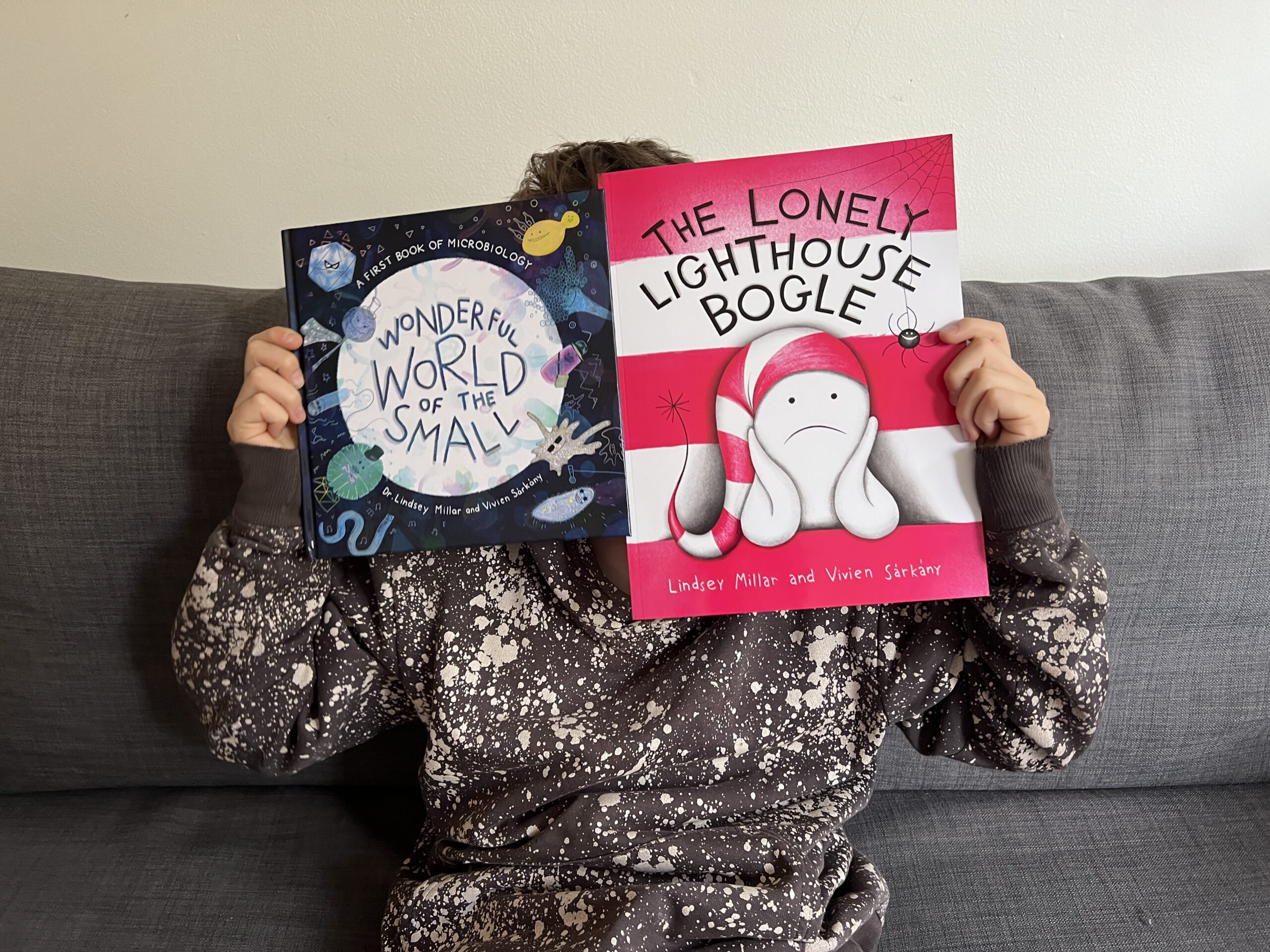
Katy - Hot Pink Wellingtons
You have such creative ideas – I especially love bringing all the blocks in the tipper truck, I know that would get my son engaged in it from the start! I have to admit that I’d never considered so many uses for flash cards – I’ve not used them, but I thought it was all about just holding up the card and saying the number / letter. I see the appeal now!
Sinead (Shinners & the Brood)
These cards are brilliant. I’d love to see something like this in Irish. My kids are educated through Irish but English is our first language. Clever with the pipe cleaners too! Lots of lovely activities.
Kate
These look gorgeous, and your photos have given me lots of ideas on how to use these. As someone with French heritage who would love her kids to be able to speak French I’m really interested in this xx
Emma | TheMiniMesAndMe
There are some lovely photos here and some great ideas on how to make the cards more fun with the activities you tried.
I like how the imagery on each is bright too to capture a child’s attention x
Jenny | Midwife and Life
So cute in the little bags! You’re so creative, I need to do more with my 3 year old.
Claire @ The Ladybirds adventures
These cards look fantastic and I love all your ideas. I’m a big fan of doing activities like these.
Cath - BattleMum
I really love the idea of these. They’re a brilliant aid when trying to teach two languages to children. I really hope they bring out Portuguese soon as they’d be a huge help to both us and our son!
Louise (@TattooedMumsy)
This all looks fab and what a great way to teach your little ones a new language :)
Rhian Westbury
Very impressive that kids are learning to be bilingual this early in life, but such a good idea x
Victoria
These cards look great! They seem so engaging. Also your photos are lovely! Thanks for sharing. I think I’ll recommend this to my cousin! x
Ana De- Jesus
I love that you support an independent company and the idea of the bilingual flash cards is such a great way of getting kids involved with learning new languages. Do they have Portuguese cards?
Jenni
I do believe they are planning to add Portuguese as one of their next languages.
Fashion and Style Police
I like the flashy cards. My kids would love it too.
Fashion and Style Police
I like the flashy cards. My kids would love them too.
Nicole - Tales from Mamaville
Wow, these look fantastic. Such a great idea! Thanks for sharing.
Anosa
Impressive and very creative, loved flash card learning when I was young, it’s a fun way to learn.
Andrea Matias
These cards look amazing and so versatile! Thanks for sharing such great ideas to use them.